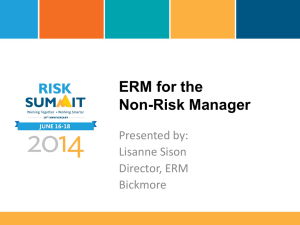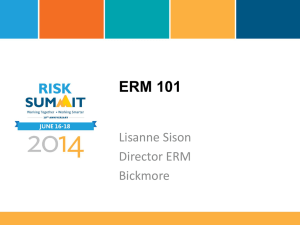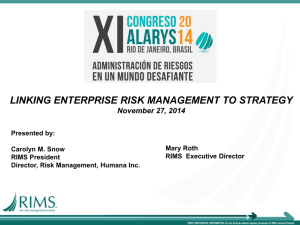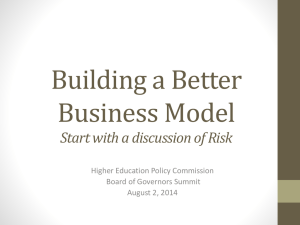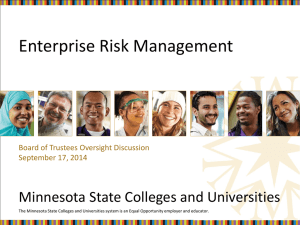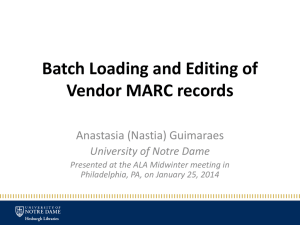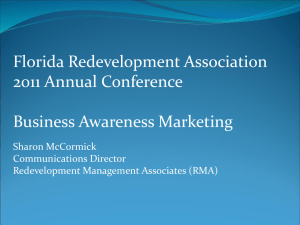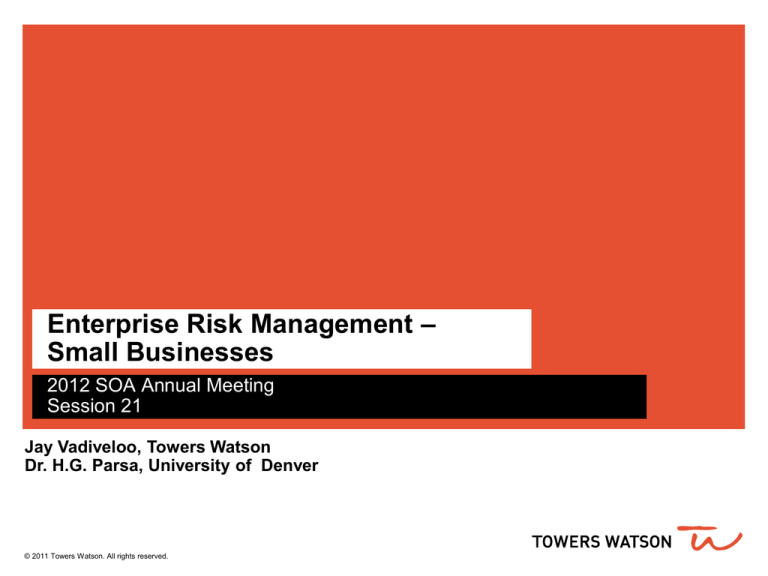
Enterprise Risk Management –
Small Businesses
2012 SOA Annual Meeting
Session 21
Jay Vadiveloo, Towers Watson
Dr. H.G. Parsa, University of Denver
© 2011 Towers Watson. All rights reserved.
Outline
Motivation for Enterprise Risk Management for Small Businesses
(ERM-SB) initiative
Why ERM-SB does not exist?
Similarities and differences between ERM for large corporations and
small businesses
ERMSB initiative at the Goldenson Center, Univ. of Connecticut
Case study – ERM analysis of the Restaurant Industry
Where do we go from here?
Conclusion
towerswatson.com
2
Motivation for ERM-SB Initiative
Small businesses are the largest, fastest growing and most
important segment of the American economy
Small businesses experience one of the highest failure rates
compared to large corporations
Lack of any institutional or formalized risk management for small
businesses
Small businesses do not practice risk management in a formalized
or organized manner.
Enterprise Risk Management is a comprehensive approach
addressing risk in all functional areas
ERM is an effective proactive prevention tool for small businesses
towerswatson.com
3
Why ERM is not popular with Small Businesses?
Small Businesses do not use ERM frequently for
Lack of familiarity
Cost of implementation
Fear of change
May be financially unable to do so
Unaware of benefits of ERM
— ERM as a prevention tool
— ERM as an early ‘wake up’ call
— ERM as a comparative analysis tool
— ERM as a financial tool
As a consequence, ERM principles and literature are tailored
primarily to large corporations
towerswatson.com
4
ERM for Large Corporations Vs. Small Businesses
Fundamental Steps are Similar
Identify and prioritize risks
Model and quantify the risks
Customize the model for the industry / firm
Create risk-mitigation strategies
ERM as an ‘exercise regime’ for healthy operation of a small business
ERM reduces insurance costs
ERM lowers workman compensation costs
ERM lowers potential risk in financial matters
ERM helps in identifying operational risks and the associated costs
towerswatson.com
5
Differences with ERM for Large Corporations
Needs to incorporate business growth strategies as well
Need to focus on reasonably likely risks with serious consequences
versus low likelihood events with serious consequences
Business owners are very knowledgeable about risks and business
growth strategies
Easier to assess and manage risks of a small business, but
consequences of a risk shock are far greater
Qualitative Risks Vs. Quantitative Risks
ERM analysis covers shorter time periods (one to three years) and
should be revisited periodically to remain relevant
towerswatson.com
6
Differences with ERM for Large Corporations: continued
A well defined ERM analysis, which incorporates business
growth strategies, can materially improve the sustainability
and profitability of a small business
towerswatson.com
7
ERM Initiative at the Goldenson Center,
Univ. of Connecticut
Successfully operating for the past three years
Numerous success stories of helping small businesses with ERM
Students are funded by the Goldenson Center to undertake ERM-SB
projects in the region
Service offered free-of-charge to small businesses
Students work in teams and provide a formal written ERM report and
any software tools at the end of each project
It is a win-win situation
Small scale operations are in progress and on-going
Restaurant industry is the ideal choice for testing ERM-SB model,
towerswatson.com
8
Enterprise Risk Management –
Restaurant Industry
© 2011 Towers Watson. All rights reserved.
ERM IN SMALL Businesses
Service Economy
Restaurants as a Case Study
One of the largest service industries in US
Over $640 Billion in annual sales
Nearly 13 million employed in this industry
Americans eat 1 in 3 meals at restaurants
A classic small business industry
towerswatson.com
ERM IN SMALL Businesses
Failure Rate in Restaurants
Over 30% of restaurants fail in the first year
Nearly 60% fail in 3 years
Survival rate dramatically increases after the 5th year
Independents have higher failure rate than chain restaurants
Failure rate depends on various factors
towerswatson.com
ERM IN SMALL Businesses
Factors in Restaurant Failure:
Macro Factors
Economy, Legislation, Tourism, Food Trends, Technology, Demographic
Shifts
Micro Factors
Prime Costs, Management, Working Capital, Quality of Life, Entrepreneurial
Incompetence, Control Systems, Cash Flow Mgmt.
towerswatson.com
ERM IN SMALL Businesses
Factors in Restaurant Failure:
1.
Size of a Restaurant: Small vs Large
2.
Ownership: Franchised Vs Non-Franchised
3.
Concept: Regional preferences
4.
Location: Downtowns Vs Suburbs
5.
Location: Zip Codes
towerswatson.com
ERM IN SMALL Businesses
Factors in Restaurant Failure:
6. Demographics – Study from Boulder, CO
7. Working Capital Vs Investment Capital
8. Cost Structure – Prime Costs
9. Economy – Tourism in particular
10. Legislation – National, Regional and Local
11. Legislation – Calories – Study
towerswatson.com
from Denver Univ.
ERM IN SMALL Businesses
Restaurant Failure Studies –
Columbus, Oh - Ohio State University
Atlanta, GA
Los Angeles, CA
Boulder, CO
Case Studies – Cornell
towerswatson.com
University Report
ERM IN SMALL Businesses
Risk Metrics and ERM in Restaurants
Financial Metrics
Operational Metrics
towerswatson.com
ERM IN SMALL Businesses
Financial Risk Metrics in Restaurants
1.
Sales per Unit
2.
Sales Growth in Dollars per Unit
3.
Sales Growth Rate over 1, 3, 5 years
4.
Ratio of Food to Beverage Sales
5.
Prime Cost (Food / Labor Cost)
towerswatson.com
ERM IN SMALL Businesses
Financial Risk Metrics in Restaurants
1.
Gross Margin
2.
IBITAD
3.
Cash Flow Analysis
4.
Debt to Income Ratio
5.
Current Asset Ratios
6.
Fixed Costs and Long term Commitments
towerswatson.com
ERM IN SMALL Businesses
Operational Risk Metrics in Restaurants
1.
Guest Check Averages
2.
Number of Seats
3.
QSC Scores
4.
Level of Ambiance
5.
Employee Turnover Ratios
towerswatson.com
ERM IN SMALL Businesses
Operational Risk Metrics in Restaurants
1.
Management Turnover Ratios
2.
Number of Seat Hours
3.
Number of Transactions (Covers)
4.
Number of Transactions per Ops. Hour
5.
Longevity of the Business
6.
Terms of Lease
towerswatson.com
Risk Metrics and
ERM in Restaurants
Expected Outcomes
Lower Failure Rates
Improved Success Rates within a System
Caution Notice for Potential Failures
Proactive Strategies when at Risk
Comparative Analysis
New Market Analysis for Risk
New Location Analysis for Risk
towerswatson.com
Risk Metrics and
ERM in Restaurants
Expected Outcomes
Lowering of Financial Risks
Improved Investment Decisions
Improved Operations
Good Public Policy –
Good Private Decisions – financial & operational
towerswatson.com
helping small businesses
Where Do We Go From Here?
Need to expand the Goldenson Center’s ERM-SB initiative in order to
make an impact in the Restaurant Industry or other business sectors
Any large scale implementation should be supported by a large
organization, corporation, private foundation and government agencies
and not necessarily by a small business
Most cost-effective way to undertake these projects is to partner with
academic institutions and engage students at universities all over the
country
towerswatson.com
23
Where do we go from here cont’d
ERM text for Small & Medium-Sized Enterprises (SME’s)
Approached by Actex publishers to write text
No such text currently exists in the ERM literature
The SOA has expressed an interest in funding this text from their 2013
research budget
Articles will be contributed by experts in the field, both practitioners
and academicians
If properly designed, this book could become a required text for
students following the SOA ERM track
towerswatson.com
towerswatson
©
2012
Tow
ers
Where do we go from here cont’d
Potential Topics for text on SME’s
Underlying principles governing ERM for SME’s
Overview of SME’s in the US
Differences/similarities between ERM principles for start-up SME’s, SME’s
in business for a few years and established SME’s
In-depth ERM analysis of some key SME business sectors based on
actual case studies
Regulatory environment for SME’s and impact on failure rates of SME’s
Steps involved to undertake an ERM analysis for a given SME sector,
including measuring and tracking results
General ERM principles and methodologies for large corporations which
can be adapted for SME’s
Best practices to create a vibrant and growing SME environment in the
US and the value of establishing a risk management culture for SME’s
towerswatson.com
towerswatson
©
2012
Tow
ers
Conclusion
The Goldenson Center has just scratched the surface in showing how
an effective ERM culture can be created with small businesses
ERM-SB is a form of micro-risk management and can be replicated
globally with funding from large corporations and other entities with
university students doing the projects
To have an impact, ERM-SB should analyze and monitor an entire
small business sector (e.g. restaurant industry, retail drug store
industry, independent marketing organizations, etc) versus individual
small businesses
Huge payoff since any reduction in the failure rate for small businesses
would be a boost to the overall economy
towerswatson.com
26
Contact Information
1. Jay Vadiveloo, Ph.D, FSA, MAAA, CFA
Professor-in-Residence & Director
Janet & Mark L. Goldenson Center for Actuarial Research,
University of Connecticut &
Senior Consultant, Towers Watson
jay.vadiveloo@towerswatson.com
2. H.G. Parsa, Ph.D., FMP
Barron Hilton Chair in Lodging & Professor of Hospitality Mgmt.
Associate Editor, Journal of Hospitality and Tourism Research (JHTR)
Fritz Knoebel School of Hospitality Mgmt.
Joy Burns Center
2044 E. Evans Ave
Daniels College of Business
University of Denver
Denver, CO 80208-2100
(303) 871-4791
hparsa@du.edu
towerswatson.com
27

